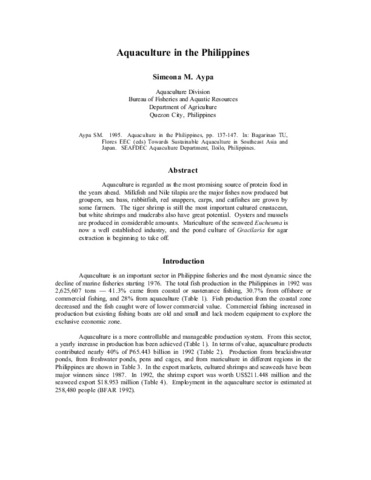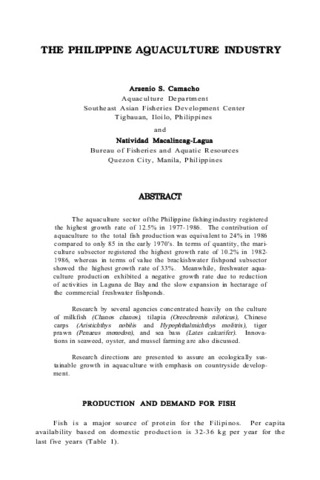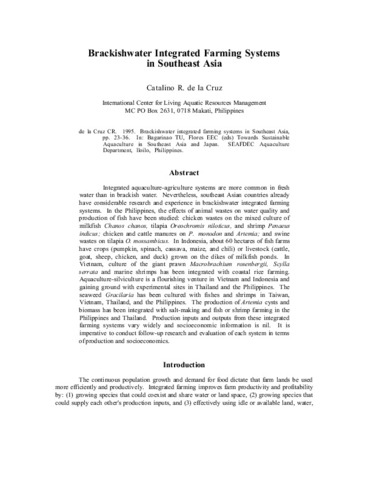| dc.contributor.author | Tendencia, Eleonor | |
| dc.contributor.author | Fermin, Armando C. | |
| dc.contributor.author | dela Peña, Milagros R. | |
| dc.contributor.author | Choresca, Casiano H., Jr. | |
| dc.date.accessioned | 2013-09-18T16:20:03Z | |
| dc.date.available | 2013-09-18T16:20:03Z | |
| dc.date.issued | 2006 | |
| dc.identifier.citation | Tendencia, E. A., Fermin, A. C., dela Peña, M. R., & Choresca Jr., C. H. (2006). Effect of Epinephelus coioides, Chanos chanos, and GIFT tilapia in polyculture with Penaeus monodon on the growth of the luminous bacteria Vibrio harveyi. Aquaculture, 253(1–4), 48–56. | en |
| dc.identifier.issn | 0044-8486 | |
| dc.identifier.uri | http://hdl.handle.net/10862/1669 | |
| dc.description.abstract | Studies have shown that the presence of Tilapia hornorum hybrid has antibacterial effect against luminous bacteria. The present study aims to determine the effect of different fish species such as grouper, milkfish and tilapia in polyculture with shrimp on the growth of luminous bacteria. Results showed that stocking of tilapia Oreochromis niloticus hybrid and grouper Epinephelus coioides at a biomass of 500 g/m3 efficiently inhibited the growth of luminous bacteria in shrimp (biomass = 80 g/m3) rearing water and positively affected shrimp survival. Results also showed that the presence of milkfish Chanos chanos at a biomass of 500 g/m3 did not inhibit the growth of luminous bacteria in shrimp (biomass = 80 g/m3) rearing water. | en |
| dc.description.sponsorship | The study was funded by the Government of Japan through the Trust Fund awarded to the Southeast Asian Fisheries Development Center Aquaculture Department (SEAFDEC AQD) under study code 6251-300-60 (GOJ TF) and SEAFDEC AQD under study code FH 07 2001T. | en |
| dc.language.iso | en | en |
| dc.publisher | Elsevier | en |
| dc.subject | Epinephelus coioides | en |
| dc.subject | Chanos chanos | en |
| dc.subject | Oreochromis niloticus | en |
| dc.subject | Penaeus monodon | en |
| dc.subject | milkfish | en |
| dc.subject | Giant tiger prawn | en |
| dc.subject | GIFT tilapia | en |
| dc.subject | groupers | en |
| dc.subject | prawns and shrimps | en |
| dc.title | Effect of Epinephelus coioides, Chanos chanos, and GIFT tilapia in polyculture with Penaeus monodon on the growth of the luminous bacteria Vibrio harveyi | en |
| dc.type | Article | en |
| dc.citation.volume | 253 | |
| dc.citation.issue | 1–4 | |
| dc.citation.spage | 48 | |
| dc.citation.epage | 56 | |
| dc.citation.journalTitle | Aquaculture | en |
| dc.subject.asfa | fish culture | en |
| dc.subject.asfa | hybrid culture | en |
| dc.subject.asfa | polyculture (aquaculture) | en |
| dc.subject.asfa | shrimp culture | en |
| dc.subject.asfa | antibiotics | en |
| dc.subject.asfa | disease control | en |
| dc.subject.asfa | aquaculture techniques | en |
| dc.subject.asfa | bacterial diseases | en |
| dc.subject.asfa | growth | en |
| dc.subject.asfa | stocking (organisms) | en |
| dc.subject.asfa | brackishwater fishes | en |
| dc.subject.asfa | luminous organisms | en |
| dc.subject.asfa | biomass | en |
| dc.subject.asfa | hybrids | en |
| dc.subject.asfa | survival | en |
| dc.identifier.doi | 10.1016/j.aquaculture.2005.06.028 | |
| dc.subject.scientificName | Penaeus monodon | en |
| dc.subject.scientificName | Tilapia hornorum | en |
| dc.subject.scientificName | Vibrio harveyi | en |
| dc.subject.scientificName | Chanos chanos | |



